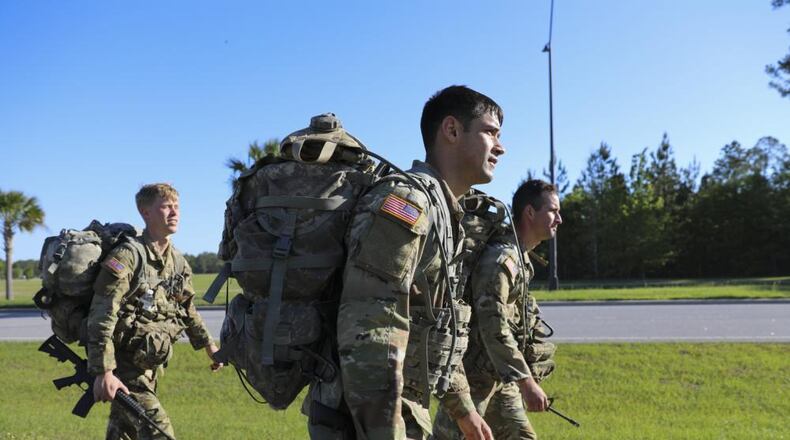Rafael Eirea-Lamberto, a combat engineer for the 9th Engineer Battalion at Fort Stewart, studies a set of instructions as his teammates wrap rope around rope. The group is immersed in an exercise testing their knowledge of a pulley system — a skill that could be used to haul heavy weaponry or an injured soldier in combat.
In the last four months, the set of six combat engineers trained rigorously on land and water, pushing their strength and mental acuity to the limit. But the preparation wasn't for an imminent deployment, but for the 15th Annual Lt. Gen. (RET) Robert B. Flowers Best Sapper Competition.
The group's training propelled two Fort Stewart soldiers to a top-10 finish in the Best Sapper Competition, held April 23-25 at Fort Leonard Wood in Missouri. The two-person team, composed of Eirea-Lamberto and Drake Titus, placed 9th out of a total of 50 teams, a best for the local base since 2019.
Credit: Courtesy of Staff Sgt. Justin McClarran
Credit: Courtesy of Staff Sgt. Justin McClarran
In 2019, the 9th Brigade Engineer Battalion placed 6th.
Since 2005, the Best Sapper competition has showcased "the Army's elite soldiers in combat engineering military occupation specialties." Over the course of three days, about a hundred combat engineers chosen to compete tested their physical prowess and mental fortitude.
"The competition is the best part," said Eirea-Lamberto, "it just makes you better ... you're competing against each other, but you're still helping each other out."
The first lieutenant competed last year and scored 15th place. "I think it was pretty good ... with just two weeks preparation," he said.
The extra training seemed to pay off this year. At 9th, Eirea-Lamberto can celebrate a personal milestone.
Credit: Courtesy of Sgt. Dre Stout, 50th Public Affairs Detachment
Credit: Courtesy of Sgt. Dre Stout, 50th Public Affairs Detachment
Specialist Kenneth Rayne, a first-timer, said he was excited to test his mettle against other engineers. The competition was an opportunity to sharpen the skills they need to use on the battlefield.
One of their main duties, Rayne explains, is opening and closing breach ways — in other words, removing obstacles so that forces can pass through, or construct obstacles for protection.
"It's our job to remove the obstacle so that the rest of our allied forces can move through and continue their mission," said Rayne. "Countermobility is the reverse of that — if we have an asset that we'd like to protect like a town or operating base, we put up obstacles."
Sometimes that's done through the use of explosives -- other times, through mechanical breaching tools, such as sledge hammers, axes, bolt cutters and more, he said.
Live demolition calculations also took place at the Best Sapper competition, said Rayne, but sappers are kept at a safe distance away.
But in real combat, engineers are often in the danger zone, said Capt. Sean Minton, the public affairs officer for the 3rd Infantry Division. Engineers have to expect 50% of their forces to be lost at the breach.
"The competition is for people to really prove themselves," said Minton, "They have to know their craft really well."
But the event is also a time for camaraderie, said Rayne. The engineer regiment is small across the U.S. Army and the Best Sapper competition is where they can make connections.
"They (soldiers) can better share their experiences, their knowledge base on engineering tasks as a whole," said Rayne, "It's where a lot of people can come together ... they can make a name for themselves and know the names of others."
Nancy Guan is the general assignment reporter covering Chatham County municipalities. Reach her at nguan@gannett.com or on Twitter @nancyguann.
This article originally appeared on Savannah Morning News: What's a 'sapper'? Fort Stewart soldiers among the U.S. Army's best combat engineers
The Latest
Featured




